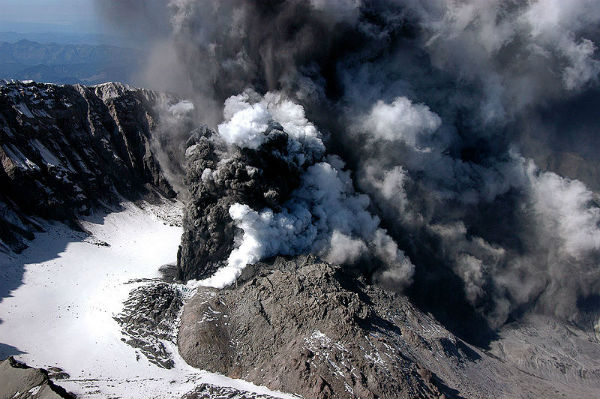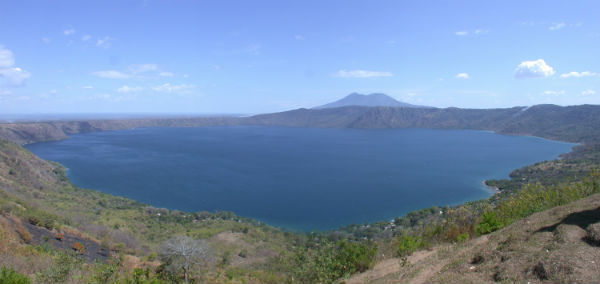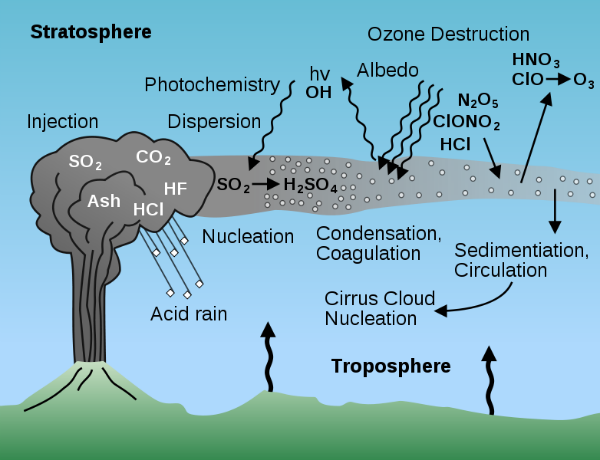Volcanic gases could deplete ozone layer

A new study has found that massive volcanic eruptions that took place over the past 70,000 years in Nicaragua could have injected enough gases into the atmosphere to temporarily thin the ozone layer. The study also concluded that if such an event took pace today, the amount of gases released could equal twice the amount of ozone-depleting halogen currently released into the stratosphere by manmade emissions. If bromine and chlorine reach the upper levels of the atmosphere, they have a high potential of depleting the ozone layer.
Taking an average from 14 Nicaraguan eruptions, Krüger and her colleagues found bromine and chlorine concentrations in the stratosphere jumped to levels that are equivalent to 200 % to 300 % of the 2011 concentrations of those gases. The Upper Apoyo eruption 24,500 years ago, for example, released 120 megatons of chlorine and 600 kilotons of bromine into the stratosphere.

Researchers analysed gases that had been trapped in minerals crystallizing in the magma chambers and estimated the amount of gas within the magma prior to the eruptions. Previous studies have estimated that in large, explosive eruptions — the type that sends mushroom clouds of ash kilometers high — up to 25 % of the halogens ejected can make it to the stratosphere.
Volcanic sulfate aerosols alone can lead to an ozone increase — if chlorine levels are at low, pre-industrial levels. But bromine and chlorine are halogens, gases whose atoms have seven electrons in the outer ring. To reach a stable, eight-electron configuration, these atoms will rip electrons off of passing molecules, like ozone. So when an eruption also pumps bromine and chlorine levels into the stratosphere, the ozone-depleting properties of the gases together with aerosols is expected to thin the protective layer.
Because the effects are in the stratosphere, where the volcanic gases can be carried across the globe, eruptions of tropical volcanoes could lead to ozone depletion over a large area, Krüger said, potentially even impacting the ozone over polar regions.

Volcanic gases include a variety of substances given off by active (or, at times, by dormant) volcanoes. These include gases trapped in cavities (vesicles) in volcanic rocks, dissolved or dissociated gases in magma and lava, or gases emanating directly from lava or indirectly through ground water heated by volcanic action.
The principal components of volcanic gases are water vapor (H2O), carbon dioxide (CO2), sulfur either as sulfur dioxide (SO2) (high-temperature volcanic gases) or hydrogen sulfide (H2S) (low-temperature volcanic gases), nitrogen, argon, helium, neon, methane,carbon monoxide and hydrogen. Other compounds detected in volcanic gases are oxygen (meteoric), hydrogen chloride, hydrogen fluoride, hydrogen bromide, nitrogen oxide (NOx), sulfur hexafluoride, carbonyl sulfide, and organic compounds. Exotic trace compounds include methylmercury, halocarbons (including CFCs), and halogen oxide radicals.
The abundance of gases varies considerably from volcano to volcano. Water vapor is consistently the most common volcanic gas, normally comprising more than 60% of total emissions. Carbon dioxide typically accounts for 10 to 40% of emissions.
Volcanoes located at convergent plate boundaries emit more water vapor and chlorine than volcanoes at hot spots or divergent plate boundaries. This is caused by the addition of seawater into magma formed at subduction zones. Convergent plate boundary volcanoes also have higher H2O/H2, H2O/CO2, CO2/He and N2/He ratios than hot spot or divergent plate boundary volcanoes
Sources: American Geophysical Union, Wikipedia
Featured image: Eruption of Mount St. Helens (Credit: USGS/John Pallister)

Commenting rules and guidelines
We value the thoughts and opinions of our readers and welcome healthy discussions on our website. In order to maintain a respectful and positive community, we ask that all commenters follow these rules:
We reserve the right to remove any comments that violate these rules. By commenting on our website, you agree to abide by these guidelines. Thank you for helping to create a positive and welcoming environment for all.